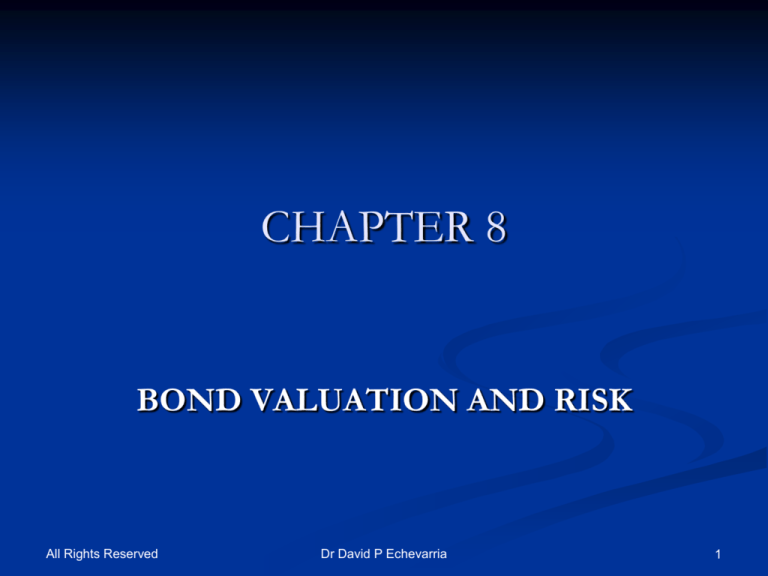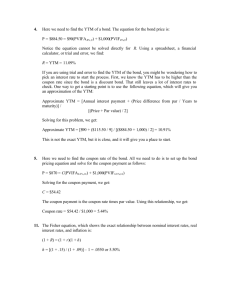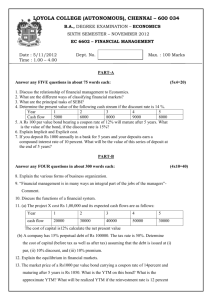
CHAPTER 8
BOND VALUATION AND RISK
All Rights Reserved
Dr David P Echevarria
1
BOND VALUATION
The value of any debt claim is equal to the sum
of the discounted future cash flows. The
discount [interest] for future cash flows is a
function of the level of riskiness for a
particular bond and is termed the Yield to
Maturity (YTM).
Bond valuation model;
1. Vb = Coupon * PVIFA + Face Value * PVIF
All Rights Reserved
Dr David P Echevarria
2
BOND VALUATION
A. Valuation of Bonds with Annual, Semi-annual, or
quarterly Payments
1.
Two cash streams are expect for each bond
a.
b.
2.
3.
Coupons
Face or maturity value
Coupons valued like an annuity
Face Value a single discounted future cash flow
B. Methods for computing Bond Market Values
1.
2.
Bond Tables
Financial Calculators (preferred)
All Rights Reserved
Dr David P Echevarria
3
USING FINANCIAL CALCULATORS
TO COMPUTE BOND VALUES
A bond pays a coupon of $120 per year, paid semi-annually.
The bond matures in 20 years and has a face value of $1,000.
If the current YTM rates are 9 percent, how much should this
bond sell for?
1. ENTER 20 [2nd] [N], [N]: Display: N =
40.00
2. ENTER 9 [I/Y]: Display: I/Y =
9.00
3. ENTER 60 [PMT]: Display: PMT =
60.00
4. ENTER 1000 [FV]: Display: FV = 1,000.00
5. PRESS [CPT] [PV]: Display: PV = -1,276.02
USING FINANCIAL CALCULATORS
TO COMPUTE BOND VALUES
A. What If Examples
1. Suppose the YTM is 11 percent; "I/Y" = 11. Enter
11, press [I/Y], then [CPT] , then [PV]; 1,080.23.
2. If the YTM is 12%; enter 12, press [I/Y], then
[CPT], [PV]; PV = 1,000.00 or $1,000.00.
3. If the YTM is 15%, the price [PV] is $811.08.
Note as YTM increases, VB decreases
Yield to First Call
A. Callable Bonds Pay Premiums
1. The premium results in a Yield-to-First-Call
different from the Coupon Rate.
2. Calling a 30-year bond 5% coupon bond four
years after issuance @ 107.50.
3. N = 4
4. PV = -1000
5. PMT = 50
6. FV = 1075.00
7. CPT I/Y = 6.70% Slide 6
All Rights Reserved
Dr. David P. Echevarria
BOND VALUATION
C. Impact of Interest Rate Movements on Bond Prices
1.
2.
3.
4.
Bond Prices move in the Opposite Direction to Interest
Rates.
Bonds will sell at discounts or premiums or equal to Face
values
Interest Rates move in the Same Direction as Inflationary
Expectations
Interest Rates move in the Same Direction as Perceived
Riskiness
All Rights Reserved
Dr David P Echevarria
7
BOND VALUATION
D. Factors Affecting Bond Price Interest Rate
Sensitivity
1.
2.
3.
The time remaining to maturity; direct relationship
The size of the coupon payments
The frequency of coupon payments; i.e., annual, Semi-,
quarterly, monthly
All Rights Reserved
Dr David P Echevarria
8
BOND VALUATION
F. Determination of Bond Yields
1.
2.
3.
Yield to Maturity (YTM)
Current Yield
Tax treatment of gains and loses
a.
b.
Premiums
Discounts
G. Using Expectations to Manage Total Returns on
Bond Portfolios
1.
2.
If you know were interest rates are going you know where
bond prices are going
Riding the yield curve or betting on the movement of
interest rates
All Rights Reserved
Dr David P Echevarria
9
Duration
A. Measuring Sensitivity to Interest Rate Movements:
Duration
1. As duration increases, the greater the sensitivity to
interest rate fluctuations
2. Sensitivity is also a function of coupon rates
a. The larger the coupon rate, the shorter the duration
b. Zero coupon bonds: duration = maturity
3. Importance of determining the investment horizon
4. Key strategy for immunizing the yield on a bond
portfolio
All Rights Reserved
Dr David P Echevarria
10
BOND PORTFOLIO MANAGEMENT
B. Use of Duration as an Immunization Strategy
"A portfolio of bonds is immunized from interest
rate risk if the duration of the portfolio equals the
desired investment horizon" Fisher and Weil
1.
2.
3.
4.
Requires a known investment horizon; when do you need
the cash?
Involves periodic adjustment in portfolio composition; see
#3 below
Increase in YTM after the position is set results in a
decrease in duration and vice-versa (Reinvestment of cash
flows at higher rates than original YTM)
Duration affected by calls, serial redemptions, and sinking
fund provisions
All Rights Reserved
Dr David P Echevarria
11
Managing Bond Risk: Duration
t
1
2
3
4
5
6
7
8
9
10
YTM =
Par Value
Price
Coupon
10.00%
$ 1,000.00
($1,000.00)
10.00%
CP
$100.00
$100.00
$100.00
$100.00
$100.00
$100.00
$100.00
$100.00
$100.00
$1,100.00
PV(CP)
$
90.91
$
82.64
$
75.13
$
68.30
$
62.09
$
56.45
$
51.32
$
46.65
$
42.41
$ 424.10
$ 1,000.00
6.7590238
Dur =
All Rights Reserved
t PV(CP)
$
90.91
$
165.29
$
225.39
$
273.21
$
310.46
$
338.68
$
359.21
$
373.21
$
381.69
$ 4,240.98
$ 6,759.02
t
1
2
3
4
5
6
7
8
9
10
YTM =
Par Value
Price
Coupon
4.00%
$ 1,000.00
($1,000.00)
4.00%
CP
$40.00
$40.00
$40.00
$40.00
$40.00
$40.00
$40.00
$40.00
$40.00
$1,040.00
PV(CP)
$
38.46
$
36.98
$
35.56
$
34.19
$
32.88
$
31.61
$
30.40
$
29.23
$
28.10
$ 702.59
$ 1,000.00
8.43533161
Dur =
Dr David P Echevarria
t PV(CP)
$
38.46
$
73.96
$
106.68
$
136.77
$
164.39
$
189.68
$
212.78
$
233.82
$
252.93
$ 7,025.87
$ 8,435.33
12
Duration for a Zero Coupon Bond
t
1
2
3
4
5
6
7
8
9
10
YTM =
Par Value
Price
Coupon
10.00%
$ 1,000.00
($385.54)
0.00%
CP
$0.00
$0.00
$0.00
$0.00
$0.00
$0.00
$0.00
$0.00
$0.00
$1,000.00
PV(CP)
$
$
$
$
$
$
$
$
$
$ 385.54
$ 385.54
10
Dur =
All Rights Reserved
t PV(CP)
$
$
$
$
$
$
$
$
$
$ 3,855.43
$ 3,855.43
Effects of Coupon Rates on
Duration:
As coupon rates increase,
duration decreases and viceversa.
As YTM decrease, duration
increases and vice versa.
The duration for a zerocoupon bond is equal to its
maturity.
Dr David P Echevarria
13
BOND PORTFOLIO MANAGEMENT
B. Use of Derivative Securities as Hedges
1. Interest rate futures, as well as options on futures
2. May also involve currency hedges
3. SWAP agreements may also be used
All Rights Reserved
Dr David P Echevarria
14
Interest Rates, Economic Activity
and Long Term Cycles
All Rights Reserved
Dr David P Echevarria
15
The Kondratieff Cycle
Where is the US (and Everyone one else) Headed?
All Rights Reserved
Dr David P Echevarria
16
All Rights Reserved
Dr David P Echevarria
17
CHAPEL HILL, N.C. (MarketWatch) — There are eerie parallels between
the stock market’s recent behavior and how it behaved right before the
1929 crash.
All Rights Reserved
Dr David P Echevarria
18
HOMEWORK QUESTIONS
A.
B.
What 2 cash flows are associated with bond investments?
What effects do interest rate increases (decreases) have on;
1.
2.
3.
C.
D.
Market values of bonds?
Current yields?
Yields to maturity?
What does it mean when a bond sells at par, at a discount, at a
premium?
What information is necessary in order to make good bond
investments?
All Rights Reserved
Dr David P Echevarria
19







